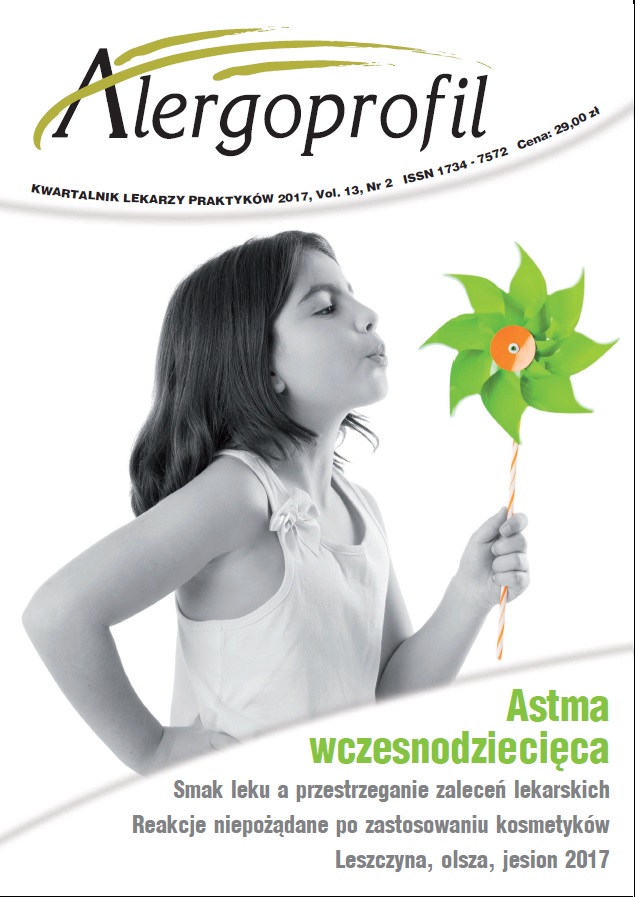Prevalence of adverse reactions after applying cosmetics among young men
Main Article Content
Abstract
Prevalence of adverse reactions after applying cosmetics among young men, students, was analyzed in the work. The study was conducted from October 2015 to April 2016, in a group of 137 persons who filled the Author‘s questionnaire. Based on obtained results, it was concluded that 28.47% of men at least once in their life had experienced adverse reactions after applying cosmetic products. Factors that have an influence on the prevalence of adverse reactions are as follows: number of cosmetics applied per day, coexisting of earlier diagnosed allergies to various factors, skin problems and age.
Downloads
Article Details
Copyright: © Medical Education sp. z o.o. This is an Open Access article distributed under the terms of the Attribution-NonCommercial 4.0 International (CC BY-NC 4.0). License (https://creativecommons.org/licenses/by-nc/4.0/), allowing third parties to copy and redistribute the material in any medium or format and to remix, transform, and build upon the material, provided the original work is properly cited and states its license.
Address reprint requests to: Medical Education, Marcin Kuźma (marcin.kuzma@mededu.pl)
References
2. Matuszewski A.: Kosmetyki dla mężczyzn. Poradnik Handlowca. Branżowy Miesięcznik Ogólnopolski dla Sklepów i Hurtowni FMCG 2005, 12(10): 132.
3. Wojciechowska M., Żbikowska-Gotz M., Bartuzi Z. et al.: Wyprysk kontaktowy alergiczny i niealergiczny: etiologia, obraz kliniczny, patomechanizm, diagnostyka i różnicowanie. Dermatol. Estet. 2012, 14(5/6): 276-284.
4. Arribas M.P., Soro P., Silvestre J.F.: Allergic Contact Dermatitis to Fragrances: Part 2. Actas Dermosifiliogr. 2013, 104(1): 29-37.
5. Wolf R., Wolf D., Tüzün B. et al.: Contact dermatitis to cosmetics. Clin. Dermatol. 2001, 19: 502-515.
6. Hamilton T., Gannes G.C.: Allergic Contact Dermatitis to Preservatives and Fragrances in Cosmetics. Skin Therapy Lett. 2011, 16(4): 1-4.
7. Kieć-Świerczyńska M.: Alergiczne kontaktowe zapalenie skóry. Uczulenie na konserwanty i paragrupę. Alergia 2010, (1): 39-43.
8. Rudzki E.: Alergia na kosmetyki. Prz. Alergol. 2004, 1: 29-31.
9. Panaszek B.: Zespół pokrzywki kontaktowej. Prz. Lek. 2005, 62(12): 1480-1483.
10. Kujawska-Dębiec K., Broniarczyk-Dyła G.: Wybrane choroby skóry spowodowane wpływem działania promieni słonecznych. Post. Dermatol. Alergol. 2008, 25(2): 61-65.
11. Jędrzejczyk-Komar M., Ryka K., Suwała-Jurczyk B.: Fotodermatozy. Lekarz 2009, 7/8: 61-67.
12. Wojas-Pelc A., Jaworek A.K., Rajzer L.: Choroby skóry związane z działaniem promieniowania słonecznego – przegląd wybranych zagadnień. Fam. Med. Prim. Care Rev. 2007, 9(1): 131-135.
13. Kacałak-Rzepka A., Bielacka-Grzela S., Różęwicka-Czabańska M. et al.: Nadwrażliwość kontaktowa na wybrane składniki kosmetyków oraz inne alergeny wśród kosmetyczek i studentek kosmetologii. Post. Dermatol. Alergol. 2010, 27(5): 400-405.
14. Śpiewak R., Doryńska A.: Częstość występowania skórnych reakcji niepożądanych na kosmetyki w miejscu pracy wśród pracowników salonów kosmetycznych. Estetol. Med. Kosmetol. 2012, 2(2): 54-57.
15. Lindberg M., Tammela M., Boström A. et al.: Are adverse skin reactions to cosmetics underestimated in the clinical assessment of contactdermatitis? A prospective study among 1075 patients attending Swedish patch test clinics. Acta Derm. Venereol. 2004, 84(4): 291-295.
16. Thyssen J.P., Linneberg A., Mennè T.: The prevalence and morbidity of sensitization to fragrance mix I in the general population. Br. J. Dermatol. 2009, 161(1): 95-101.
17. Warshaw E.M., Buchholz H.J., Belsito D.V. et al.: Allergic patch test reactions associated with cosmetics: retrospective analysis of cross-sectional data from the North American Contact Dermatitis Group, 2001-2004. J. Am. Acad. Dermatol. 2009, 60(1): 23-38.
18. Wiechuła D., Szybiak J.: Częstość występowania reakcji niepożądanych po użyciu kosmetyków wśród studentek Śląskiego Uniwersytetu Medycznego w Katowicach. Prz. Dermatol. 2013, 100(6): 392-399.
19. Søsted H., Rustemeyer T., Gonçalo M. et al.: Contact allergy to common ingredients in hair dyes. Contact Dermatitis. 2013, 69(1): 32-39.
20. Kumar P., Paulose R.: Patch testing in suspected allergic contact dermatitis to cosmetics. Dermatol Res Pract. 2014. DOI: 10.1155/2014/695387.
21. Biesterbos J.W., Dudzina T., Christiaan J.E. et al.: Usage patterns of personal care products: important factors for exposure assessment. Food Chem. Toxicol. 2013, 55: 8-17.
22. Kohl L., Blondeel A., Song M.: Allergic contact dermatitis from cosmetics. Dermatology 2002, 204: 334-337.
23. Duerte I., Campos Lage A.C.: Frequency of dermatoses associated with cosmetics. Contact Dermatitis 2007, 56(4): 211-213.
24. Wojciechowska M., Kołodziejczyk J., Mućka J. et al.: Występowanie objawów ubocznych i alergii na wybrane składniki kosmetyków u osób z chorobami alergicznymi. Post. Dermatol. Alergol. 2010, 27(6): 456-459.
25. Simonsen A.B., Deleuran M., Mortz C.G. et al.: Allergic contact dermatitis in Danish children referred for patch testing – a nationwide multicentre study. Contact Dermatitis. 2014, 70(2): 104-111.

